
Tiago Falótico / USP
In the Serra da Capivara National Park, sticks serve as tools for finding food (at left); the use of stones to crack fruit is more common among the species (at right)Tiago Falótico / USPWith a stone held high above his head, young Porthos begins vigorously pounding the sandy soil to dig a hole. His goal: a spider that he soon manages to flush out, rolling the prey between his paws to stun it before he eats it. Porthos is a capuchin monkey of the species Sapajus libidinosus, which inhabits the Serra da Capivara National Park in the Brazilian state of Piauí, and the subject of a study by researchers from the Institute of Psychology at the University of São Paulo (IP-USP). Biologist Tiago Falótico has described how these animals use tools (see Pesquisa FAPESP Issue No. 196) and showed, in an article published in July 2017 in the journal Scientific Reports, that the action of the young male involves knowledge, learning and transmission of cultural practices–or traditions, as some prefer to call them when the subjects are not humans–among social groups. The study is central to a theoretical body of knowledge that seeks to interlace biology, the social and the human sciences, and recently culminated in the formation of the Cultural Evolution Society. Its inaugural meeting was held in Germany on September 13-15, 2017.
Up to now, using stones as tools for digging has only been documented among that population. When it comes to flushing out spiders in particular, experience is needed. The study, which was the result of observations made during Falótico’s doctoral studies, completed in 2011 under the supervision of biologist Eduardo Ottoni, shows that nearly 60% of adult and young capuchins (like Porthos) are successful in the task. Juvenile monkeys (which correspond to children), on the other hand, are only able to do so in just over 30% of the cases. This is because they need to be able to recognize the silk lining that closes off the spider’s nest, a sign that the inhabitant is inside. “Juvenile capuchins sometimes dig up a nest that had just been revealed by another monkey,” Falótico says. Underground structures of Thiloa glaucocarpa tubers that look like potatoes are also more easily dug up by the adults. Yet Ocotea sp. roots, another food eaten by these primates, despite involving the use of bigger stones, do not appear to be as big a challenge to these novices. Monkeys of both genders are equally adept at using stones to dig and have an equivalent rate of success, although males seem to be more interested in the activity: among the 1,702 situations observed, 77% involved males and just 23% involved females.
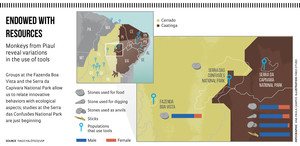 “We hoped to find a correlation between the use of tools and the scarcity of food, but that is not what we saw,” says Falótico. If the Serra da Capivara monkeys find something edible that requires the use of tools, they use them. Their lifestyle, in which they spend half of the time on the ground surrounded by sticks and stones, seems perfectly suited to development of these skills. But there is more. Although there is no difference between the genders in terms of food habits, the females never use sticks, which their male counterparts wield to flush lizards out of cracks and remove insects from tree trunks. The only apparent difference is in the level of interest. “When a male sees another male using a stick, he watches closely; but a female, even if right beside the one using the tool, is not interested and looks the other way!”
“We hoped to find a correlation between the use of tools and the scarcity of food, but that is not what we saw,” says Falótico. If the Serra da Capivara monkeys find something edible that requires the use of tools, they use them. Their lifestyle, in which they spend half of the time on the ground surrounded by sticks and stones, seems perfectly suited to development of these skills. But there is more. Although there is no difference between the genders in terms of food habits, the females never use sticks, which their male counterparts wield to flush lizards out of cracks and remove insects from tree trunks. The only apparent difference is in the level of interest. “When a male sees another male using a stick, he watches closely; but a female, even if right beside the one using the tool, is not interested and looks the other way!”
Monkeys of the same species that inhabit the Fazenda Boa Vista in Gilbués, in the state of Piauí, nearly 300 kilometers (km) to the southwest, have different traditions of tool use. There, a region more influenced by the Cerrado savannah than the Caatinga scrublands, stones are less plentiful, but necessary (and used) to crack open coconuts. There are plenty of sticks, but they have no use. That cultural difference between the groups of monkeys was explored in an experiment conducted by psychologist Raphael Moura Cardoso as he pursued his doctorate under the supervision of Eduardo Ottoni, reported in a 2016 article published in the journal Biology Letters. At both the Fazenda Boa Vista and the Serra da Capivara National Park, researchers set out acrylic boxes containing sugarcane molasses. The only way to remove the tasty treat was through a slit at the top of the box, just wide enough to fit a stick. “In the Serra da Capivara, one male hit the box with a stone,” recalls Ottoni, who, by thinking ahead, had designed the device to be “capuchin monkey-proof.” “When nothing happened, he tossed the stone aside, scratched his head and picked up a stick.” Ottoni jokes, saying that they did not even have to edit the video to be shown at a conference–continuous activity began immediately. For the five days they were exposed to the box, 10 of the 14 males used the stick during their first exposure, and except for the three youngest, all males succeeded in about 90% of their attempts. The females made no attempts, nor did the males at the Fazenda Boa Vista. There the researchers even tried to help them: after six hours of being exposed to the task, the males found a stick pre-inserted in the slit. Even after removing it and licking the molasses, none of them reinserted the tool into the box over the 13 days of the experiment. One surprise was that the monkeys at Boa Vista, experts at cracking coconuts, did not try to break the box. “They were the ones I expected would do that, not the others,” Ottoni says.
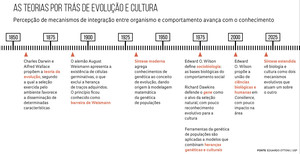 Social learning
Social learning
The surprising results may underscore the importance of the transmission of traditions among monkeys. The cover of the July 25, 2017 issue of the journal PNAS carries a photo of an adult capuchin male on the Fazenda Boa Vista eating a nut he was able to crack using a large round stone, closely observed by a young male. The image advertises the special collection on how culture is related to biology, which includes a paper by the group led by primatologists Patrícia Izar, of IP-USP, Dorothy Fragaszy, of the University of Georgia in the United States, and Elisabetta Visalberghi, of Italy’s Institute of Cognitive Sciences and Technologies, about the monkeys on the Fazenda Boa Vista they have studied systematically since 2006. Observations made over time call attention to the adults’ tolerance in relation to the young apprentices that watch closely and even eat some morsels of broken coconut. “The adults compete for resources and the immature ones are able to stay nearby,” says Izar. The analyses published in the recent article show much more than just proximity: the breakers of the coconut are able to influence the activity of the others, especially the juveniles who also begin to handle stones and coconuts. This goes on for a few minutes. “The tradition channels the activity to the same type of important actions involved in this tradition,” she says.
Izar points out that the monkeys are born within this context. “We often see infants on the backs of their mothers while they are breaking coconuts,” she says. As a result of this continuous learning, they end up becoming experts at the task. But it is not enough to just watch, and therein lies the importance of the infants’ attraction to adult activities–especially those that are most effective. “The success derives from the perception of the task and the properties of the tool,” she adds, describing a complex body-tool that constantly calls for adjustment of strength, gestures and position. When they crack open tucum, a slightly softer coconut, the monkeys adjust the force of the strikes when they hear the sound of the surface cracking, the group demonstrated in a 2016 article in the journal Animal Behaviour. For coconuts that are more difficult to crack, they select stones that can weigh more than their own body weight. And the selection of a stone is carefully made as shown in an experiment conducted by Izar and her group, where they provided artificial stones of different sizes, weights and densities. The large stones quickly got the attention of the monkeys, but if they were not dense enough–lighter than they seemed– they were abandoned. “The monkeys are able to perceive that weight is important to the act of breaking,” says Izar.
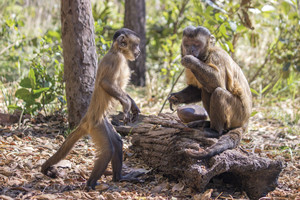
Luca Antonio Marino
Tolerance: juvenile capuchin monkey watches an adult male eat a nut it had just broken open at the Fazenda Boa VistaLuca Antonio MarinoThese primate societies are changing the environment. Monkeys select flattened stones or tree-trunks to serve as a base on which to crack coconuts, and to those places, they carry the rare large hard stones they find in their surroundings. That set-up is significant not just for creating work areas for breaking things open, but also for channeling possibilities for learning, since everyone knows where the activity takes place and can be observed. “It doesn’t make sense to think about motor maturation outside the social and food context,” says biologist Briseida Resende, also from IP-USP, and co-author of the PNAS paper. An individual’s development depends on its own experiences and physical abilities and the accumulated collection of group abilities, in which an innovation could be disseminated to eventually become part of the culture maintained for generations. Resende holds that the individual and society are inseparable, although they have historically been viewed as distinct entities.
Revised theory
Combining cultural and biological evolution is precisely the focus of the extended synthesis, now firmly rooted in the 2016 establishment of the Cultural Evolution Society–the first president is zoologist Peter Richerson from the University of California at Davis, whose group is expert in statistics. That integrated vision expands the evolutionary view, since the transmission of ideas and innovations does not just occur from parents to offspring, and may carry selective advantages that favor relevant cognitive and social abilities. It also believes that culture may influence physical aspects, such as the shape and size of the brain, or the development of skills that in turn establish behavior. Genes and culture, two channels for transmitting information, relate on a two-way street.
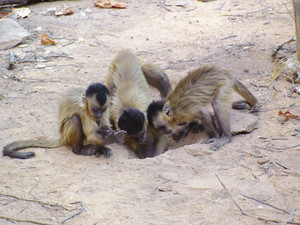
Tiago Falótico / USP
Young monkeys try to take advantage of the digging done by a femaleTiago Falótico / USPThe opportunity to see behaviors emerge and spread is rare, and this is why experimental approaches that promote innovations are an important addition to the various behaviors of the capuchin monkeys of Piauí. Recent statistical tools could help enhance that understanding. One such tool is Network-Based Diffusion Analysis, which Ottoni’s group is beginning to use. “The program sets up a random social network and compares it to the actual one,” the researcher explains. This makes analyses stronger by inserting characteristics measured in these subjects. In August 2016, at the Joint Meeting of the International Primatological Society in Chicago, Ottoni presented the findings of an experiment conducted by Camila Coelho, his doctoral student during a period at Durham University in the United Kingdom, to understand the method. The findings indicate that, in the case of capuchin monkeys, social learning predicts the dissemination of information within the species.
Up to a century ago, the use of tools was regarded as exclusively human. In observing chimpanzees in Tanzania, Great Britain’s Jane Goodall debunked this exclusivity and, to a certain extent, engendered a redefinition of the boundaries between people and animals. Much has been discovered since then, but talking about animal culture still gives rise to some discomfort. Maybe not for much longer.
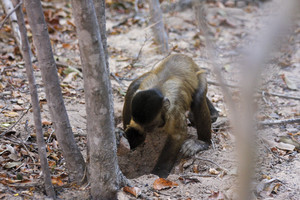
Tiago Falótico / USP
The use of stones for digging was only described in the Serra da Capivara National ParkTiago Falótico / USPUnder the influence of hormones
The level of care given to offspring is associated with the oxytocin hormone in mammals. A few years ago, the group led by Maria Cátira Bortolini of the Federal University of Rio Grande do Sul, described variants of the oxytocin molecule in species of monkeys in which there are good parents (see Pesquisa FAPESP Issue No. 228). Pharmacological tests conducted in the laboratory of biochemist Claudio Costa-Neto, at the Ribeirão Preto School of Medicine at USP, have now revealed the path of oxytocin inside the cells, and verified that the receptors of the altered forms are more exposed in the cell membranes, so that the system does not become desensitized. “It’s as if the monkey constantly received the instruction “I have to take care of the infants,” explains Bortolini. It makes a difference for the survival of marmosets, which often give birth to twins.
The findings appear in an article published in August 2017 in the journal PNAS, which also describes the results of treating rats with oxytocin variants administered through nasal drops in an experiment conducted in collaboration with physiologist Aldo Lucion of UFRGS. Lactating females, already awash in oxytocin, showed very little change in behavior. Males treated with the hormone, however, dramatically changed their habit of ignoring their offspring and ran to sniff them, a reaction that was three times faster when using marmoset oxytocin.
The Cebidae family that includes capuchin monkeys also has a type of oxytocin that increases the propensity for paternal caregiving. The groups led by Bortolini and Ottoni recently began collaborating on a study of the genetic characteristics of males that were more or less involved in caregiving. “We have already managed to extract genetic material from feces samples and we are selecting candidate genes to be tracked,” Bortolini says, fascinated with the tolerance of the males and the cognitive abilities of the primates of Piauí. “The capacity to innovate on the one had while on the other, sit and watch, are necessary for the development and transmission of adaptive cultural traits, and there is certainly a genetic scenario behind that.”
Projects
1. Tool use by wild bearded capuchin monkeys (Sapajus libidinosus): ecology, socially biased learning and behavioral traditions (No. 14/04818-0); Grant Mechanism Thematic Project; Principal Investigator Eduardo Benedicto Ottoni (USP); Investment R$609,276.69.
2. Social behavior variability of capuchin monkeys (genus Cebus): Comparative analysis among populations for the study of physiological correlates (No. 08/55684-3); Grant Mechanism Auxílio à Pesquisa – Regular Research Grant; Principal Investigator Patrícia Izar (USP); Investment R$186,187.33.
3. Development of new ligands/drugs with selective antagonism action (biased agonism) for receptors of the renin-angiotensin and kallikrein-kinin systems: New properties and biotechnological applications (No. 12/20148-0); Grant Mechanism Thematic Project; Principal Investigator Claudio Miguel da Costa Neto (USP); Investment R$3,169,674.21.
Scientific articles
FALÓTICO, T. et al. Digging up food: excavation stone tool use by wild capuchin monkeys. Scientific Reports. v. 7, n. 1, 6278. 24 jul. 2017.
CARDOSO, R. M. e OTTONI, E. B. The effects of tradition on problem solving by two wild populations of bearded capuchin monkeys in a probing task. Biology Letters. v. 12, n. 11, 20160604. nov. 2016.
FRAGASZY, D. M. et al. Synchronized practice helps bearded capuchin monkeys learn to extend attention while learning a tradition. PNAS. v. 114, n. 30, p. 7798-805. 25 jul. 2017.
MANGALAM, M., Izar, et al. Task-specific temporal organization of percussive movements in wild bearded capuchin monkeys. Animal Behaviour. v. 114, p. 129–137. abr. 2016.
PARREIRAS-E-SILVA, L. T. et al. Functional new world monkey oxytocin forms elicit na altered signaling profile and promotes parental care in rats. PNAS. v. 114, n. 34, p. 9044-49. 22 ago. 2017.
VISALBERGHI, E. et al. Selection of effective stone tools by wild bearded capuchin monkeys (Cebus libidinosus). Current Biology, v. 19, n. 3, p. 213-17. 10 fev. 2009.
